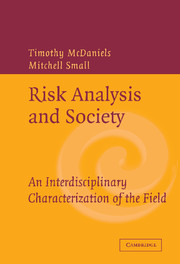Book contents
- Frontmatter
- Contents
- Contributors
- 1 Introduction – Risk Anaysis and Society: An Interdisciplinary Characterization of the Field
- PART ONE FUNDAMENTAL CHARACTER OF RISK
- 2 The Conception of Variability in Risk Analyses: Developments Since 1980
- 3 Mechanistic Considerations in the Harmonization of Dose-Response Methodology: The Role of Redundancy at Different Levels of Biological Organization
- 4 Risk of Extreme and Rare Events: Lessons from a Selection of Approaches
- 5 Environmental Risk and Justice
- PART TWO METHODS FOR RISK ASSESSMENT
- PART THREE NEW APPROACHES AND NEEDS FOR RISK MANAGEMENT
- SUMMARY AND FUTURE DIRECTIONS
- Index
- References
5 - Environmental Risk and Justice
Published online by Cambridge University Press: 05 June 2012
- Frontmatter
- Contents
- Contributors
- 1 Introduction – Risk Anaysis and Society: An Interdisciplinary Characterization of the Field
- PART ONE FUNDAMENTAL CHARACTER OF RISK
- 2 The Conception of Variability in Risk Analyses: Developments Since 1980
- 3 Mechanistic Considerations in the Harmonization of Dose-Response Methodology: The Role of Redundancy at Different Levels of Biological Organization
- 4 Risk of Extreme and Rare Events: Lessons from a Selection of Approaches
- 5 Environmental Risk and Justice
- PART TWO METHODS FOR RISK ASSESSMENT
- PART THREE NEW APPROACHES AND NEEDS FOR RISK MANAGEMENT
- SUMMARY AND FUTURE DIRECTIONS
- Index
- References
Summary
INTRODUCTION
Traditionally, risk was the province of scientists and engineers; justice, the province of ethicists. Their conjunction received little systematic study. Over the past few decades, however, they have been linked in political action as well as academic deliberation, particularly on issues concerning environmental risks to human health and safety. By now, the compelling need to consider whether environmental risks contribute to injustice is clear.
The purpose of this chapter is to provide a comprehensive overview of environmental risk and justice. Specifically, the paper has four objectives: (1) to elucidate the relationship between environmental risk and justice; (2) to examine developments in environmental justice, as that term is popularly conceived; (3) to consider a broader conception of environmental justice – one that includes but extends beyond anthropocentric concerns; and (4) to suggest work needed within risk assessment, social science, and ethics, in order to improve our collective ability to manage environmental risks in a just manner. The paper draws primarily upon experiences in the United States but refers to international and global concerns as well.
To begin, six basic questions are considered. These questions focus on factors central to environmental risk and justice:
The principles of justice invoked;
The origin of the risk;
how the risk is managed;
the distribution of risks and benefits;
the severity of the risk; and
the risk decision process.
By understanding how these factors play out in the abstract, actual experiences with environmental risk and justice can be better understood.
- Type
- Chapter
- Information
- Risk Analysis and SocietyAn Interdisciplinary Characterization of the Field, pp. 119 - 160Publisher: Cambridge University PressPrint publication year: 2003



